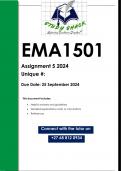Exam (elaborations)
EMA1501 Assignment 5 (QUALITY ANSWERS) 2024
- Course
- Institution
- Book
This document contains workings, explanations and solutions to the EMA1501 Assignment 5 (QUALITY ANSWERS) 2024. For assistance whats-app us on 0.6.8..8.1.2..0.9.3.4. QUESTION 1: PRE-NUMBER CONCEPTS (25) Read the statement below and answer the questions that follow. From birth already, children ar...
[Show more]













